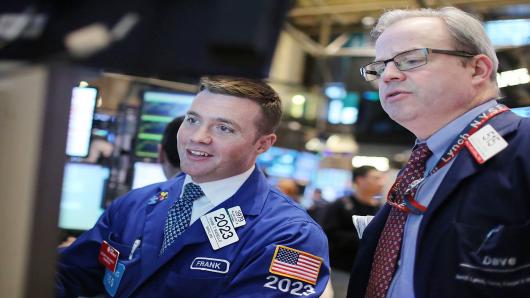"The economy is better than we expect or expected, and it's going to continue a bit here—ignoring the 'sell in May' argument— which I still think is valid," said Dan Greenhaus, global market strategist at BTIG. "I still think the rotation has a bit more legs," Greenhaus said. Since the beginning of last week, the market was led higher by tech, energy, and materials, all sectors that lost ground from mid-March to mid- April. Those sectors were among the leaders in Friday's rally.
There were 165,000 nonfarm payrolls created in April, above the consensus 145,000 expected, and the unemployment rate fell to 7.5 percent from 7.6 percent. "It's a breath of fresh air, but I still think job growth is slowing," said Mark Zandi, chief economist at Moody's Analytics.
(Read More: Back in Business: Jobs Picture Brightens in April)
Revisions to previous reports were large, including a 50,000 increase in March, taking its weak number to 138,000. The February report, already a strong 268,000, was revised to 332,000.
Other data released Friday was less encouraging. The ISM nonmanufacturing index fell to 53.1, the lowest level since last July, and factory orders fell four percent in March, more than the three percent decline economists had expected. Stocks shrugged off those reports and continued to rally.
The jobs report was a just right mix of softness and not so bad information for hiring to keep the Fed active in its asset purchase program. Analysts say the Fed helped put a floor under the market this week when it said it could taper those $85 billion monthly purchases of Treasurys and mortgage securities, or increase them if job growth or the level of inflation warranted.
"The upward revisions certainly are welcome news. It means the economy is still resilient but not exactly robust," said Mesirow Financial chief economist Diane Swonk. "This is not enough to knock the Fed out of the game in June. They'll stay in the game, but it's enough reassurance that the economy is not falling off a cliff. That's good news these days."
Manufacturing jobs showed no growth in April, but the service sector gained 185,000 and retail gained 29,000. Construction lost 6,000.
"An anomaly here is you've got no gain in goods production at all. The drop in construction is confusing because home building is booming," said John Canally, investment strategist and economist at LPL Financial.
"I think the weather had some impact."
The hours worked declined in the report by 0.2 percent. "That was the one blemish in the report," said Zandi. "Every 0.1 in horus works translates to a couple hundred thousand jobs."
Zandi said it is inconclusive but the shorter work week could be the result of two things—government budget cuts that resulted in furloughs and the Affordable Care Act. Employers may be reducing workers hours to under 30 per week, so they have less full-time workers, keeping the number under the 50 level that would require small firms to pay healthcare. The average workweek fell to 34.4 hours. A broader measure of unemployment, which includes discouraged workers and part-time workers seeking full-time work, rose to 13.9 percent from 13.8 percent.
"It looks like the number of people working part-time rose," he said. Zandi said it's hard to say but sectors that showed declines in hours worked included industries where there are many small firms. For instance, there was a 0.3 drop in retail, and there were 0.1 drops in leisure and hospitality, and construction. Hours worked also declined in manufacturing, but he said that could be the result of the impact of government spending cuts on the defense industry.



